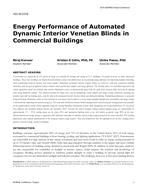Description
Fenestrations are responsible for 4.3 quads of energy use annually for heating and cooling of U.S. buildings, 2.6 quads of which are from commercial buildings. Thus, these buildings can benefit from fenestration systems that further focus on maximizing energy efficiency and improving daylight harvesting, while maintaining occupant thermal and visual comfort. Motorized, automated interior venetian blinds are tested in a full-scale commercial building laboratory with the goal of improved balance between visual and thermal comfort, and energy efficiency. The shading devices are controlled using multi-step custom algorithms, which use feedback from interior illuminance sensors to automatically adjust both the angle of the venetian blind slats and the lighting levels using dimmable controls. Two identical parallel test rooms were used for daylighting, visual comfort and energy savings evaluation, including one baseline room with no shading device, and the other with automated interior venetian blinds and dimmable lighting. Daylighting performance is measured using work plane illuminance values in three locations in each room; visual comfort is assessed using simplified daylight glare probability and energy savings is determined by comparing sub-metered energy use. The room with automated venetian blind is equipped with commercial grade shading motor and controller for the application of custom control algorithm using the existing Building Automation System. Both daylighting and energy performance are assessed in three different sky conditions between March and September 2017. Overall, the control strategies utilized reduced lighting energy use substantially, by approximately 35 – 55%, cooling energy use by about 25% and maintained lighting levels at eye level within acceptable range 90% of the time. Measurement-based energy savings is augmented with calibrated simulation to calculate annual energy saving potential of the system installed. The resulting performance data indicate improvements in the occupant comfort-energy balance. They also demonstrate that the appropriate use of these shading devices promises increased energy savings in buildings.
Citation: 2018 Annual Conference, Houston, TX, Conference Papers
Product Details
- Published:
- 2018
- Number of Pages:
- 8
- Units of Measure:
- Dual
- File Size:
- 1 file , 1.6 MB
- Product Code(s):
- D-HO-18-C018




